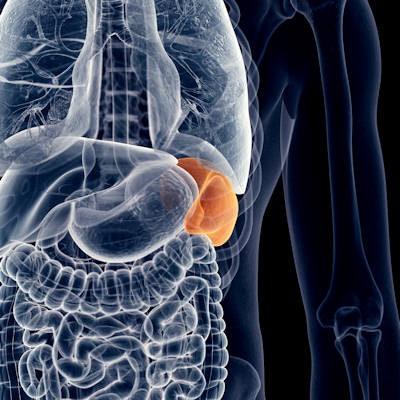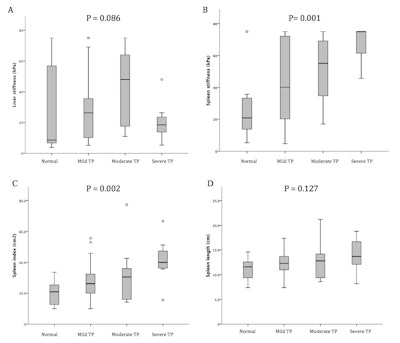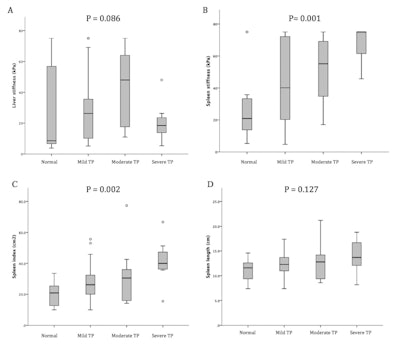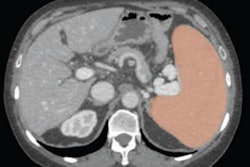
The progression of thrombocytopenia, or blood platelet deficiency, in cirrhotic patients is directly determined by pathophysiologic changes in the spleen that can be assessed on ultrasound elastography, according to research published in the September issue of the Journal of Ultrasound in Medicine.
In a prospective study involving nearly 70 patients with cirrhosis, a Taiwanese research team found that transient ultrasound elastography measures of spleen stiffness had a statistically significant correlation with blood platelet count and spleen size. Liver stiffness values on elastography failed to achieve the same correlation, however.
"The degree of thrombocytopenia was directly correlated with spleen stiffness values in cirrhotic patients, irrespective of the presence of splenomegaly," said senior author Dr. Chih-Lang Lin, PhD, of Chang Gung Memorial Hospital and Chang Gung University. "The clinical phenomenon of unexpected thrombocytopenia may be explained by a subtle or irreversible change in spleen stiffness."
Chronic hepatitis B
Taiwan has a high prevalence of chronic hepatitis B, with more than 10% of the population infected by the virus, according to Lin. Patients with chronic hepatitis B face an increased risk of developing hepatic cirrhosis and related complications, such as thrombocytopenia.
 Dr. Chih-Lang Lin, PhD, of Chang Gung Memorial Hospital and Chang Gung University.
Dr. Chih-Lang Lin, PhD, of Chang Gung Memorial Hospital and Chang Gung University."However, the exact pathogenesis of thrombocytopenia in the context of chronic liver disease is not yet fully understood," Lin told AuntMinnie.com. "Changes in the density of the spleen should also be expected in this context, owing to tissue hyperplasia and fibrosis and portal and splenic congestion associated with the splanchnic hyperdynamic state."
Because changes in spleen stiffness can be quantified by transient elastography, the researchers sought to investigate the role of spleen stiffness in determining the degree of thrombocytopenia. They prospectively evaluated 67 patients with compensated cirrhosis from November 2010 to November 2011 (J Ultrasound Med, September 2016, Vol. 35:9, pp. 1849-1857).
Over the course of one day, patients received hematologic and biochemical testing, sonography, and transient elastography of the liver and spleen. Splenic size was determined on ultrasound using two measures: splenic index and spleen length. The ultrasound exams were performed on an SSA-700A ultrasound scanner (Toshiba Medical Systems) with a 3.75-MHz convex probe, while liver and spleen stiffness measurements were acquired by transient elastography on a FibroScan system (Echosens) after at least six hours of fasting, according to the group.
For the purposes of the study, thrombocytopenia was defined as a platelet count of less than 150,000/µL. A platelet count of 75,000-150,000 µL was considered to be mild thrombocytopenia, a count of 50,000-75,000 µL was categorized as moderate thrombocytopenia, and a count of less than 50,000/ µL was considered severe thrombocytopenia. Of the 67 patients, 53 (79%) had thrombocytopenia; 32 (60%) had mild, 13 (25%) had moderate, and eight (15%) had severe thrombocytopenia.
Spleen stiffness measurements and spleen size had a statistically significant correlation with the degree of thrombocytopenia, but liver stiffness and spleen length did not, the researchers found.


Distribution of liver stiffness (A), spleen stiffness (B), splenic index (C), and spleen length (D) values at different degrees of thrombocytopenia (TP). Spleen stiffness and the splenic index were significantly correlated with the degree of thrombocytopenia, but liver stiffness and spleen length were not. Image courtesy of the Journal of Ultrasound in Medicine.
Is splenomegaly a factor?
Lin and colleagues also analyzed the results specifically for a subgroup of 48 patients with splenomegaly (an enlarged spleen), which was defined as having a splenic index of at least 20 cm2. Of these 48 patients, 40 (83%) had thrombocytopenia; 24 had mild thrombocytopenia, seven had moderate thrombocytopenia, and nine had severe thrombocytopenia.
The researchers found the following mean spleen stiffness values in this subgroup:
- Patients with thrombocytopenia: 54.0 ± 22.7 kilopascals
- Patients without thrombocytopenia (a normal platelet count): 36.6 ± 25.4 kilopascals
- Patients with moderate to severe thrombocytopenia: 62.4 ± 16.3 kilopascals
- Patients with mild thrombocytopenia or a normal platelet count: 45.4 ± 25.1 kilopascals
The difference in spleen stiffness values between patients with and without thrombocytopenia neared statistical significance (p = 0.59). However, the difference in spleen stiffness values between the group of patients with moderate to severe thrombocytopenia and those with either mild thrombocytopenia or a normal platelet count was statistically significant (p = 0.007).
The researchers noted that mean liver stiffness values were also higher in patients with thrombocytopenia than in those without thrombocytopenia. That difference did not reach statistical significance, however (p = 0.105).
In a similar dynamic, spleen stiffness values were significantly higher (p = 0.035) in patients who had thrombocytopenia without splenomegaly than in those without thrombocytopenia and splenomegaly. Liver stiffness values were also not statistically significant between the two groups of patients (p = 0.174).
"Our study demonstrated that although liver stiffness was significantly correlated with the platelet count, spleen stiffness had a better correlation with different degrees of thrombocytopenia as well as the splenic index in patients with cirrhosis," Lin said. "Furthermore, in patients with splenomegaly, significantly higher spleen stiffness values were observed in patients with moderate to severe thrombocytopenia; however, liver stiffness values did not follow the same trend. Even in patients without splenomegaly, significantly higher spleen stiffness values, but not liver stiffness values, were observed in patients with thrombocytopenia."
Transient elastography measurements of spleen stiffness offer a quantitative indicator of pathophysiologic changes in the spleen caused by portal hypertension, according to the group.
"These pathophysiologic changes in the spleen directly determine the progression of thrombocytopenia," the authors wrote.
The researchers are continuing to study the use of ultrasound elastography in this application, Lin said.
"We hope to use this spleen stiffness measurement with [its] safety and convenience feature[s] for solving some problems about liver cirrhosis," he said.




















